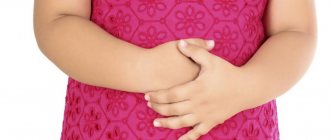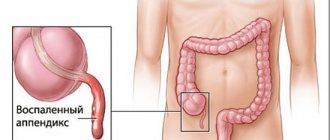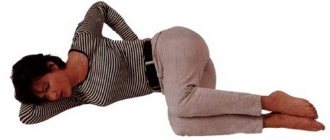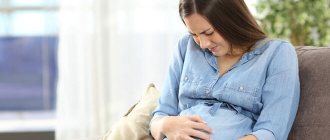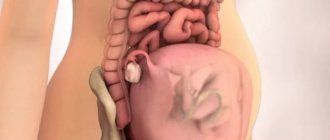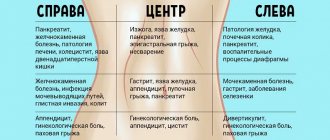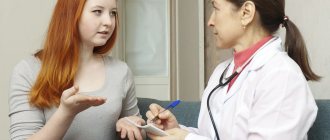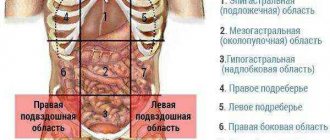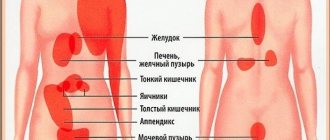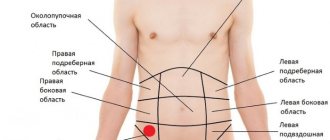If a child has pain on the left side, correct and timely diagnosis is important, which can only be performed competently by a doctor. Discomfort is of a different nature and has a different nature of origin. Sometimes pain appears in the left side when playing sports; in such situations, treatment is not necessary.
There are many reasons why a child experiences pain in the left side.
Organs located on the left side
In addition to physical activity, malfunctions in many internal systems of the body can provoke pain on the left side. Aching or acute attacks may occur due to the abnormal structure of organs or damage to them by infections or bacteria.
On the left side are:
- spleen;
- intestines;
- left side of the diaphragm;
- pancreas.
To understand the cause of pain, the doctor prescribes an examination, since the symptoms of many diseases are very similar.
On a note! Girls often experience pain in the lower abdomen due to hormonal changes and the formation of the reproductive system in the body. In this case, you need to consult a gynecologist.
Causes of pain
In fact, there are many reasons that cause abdominal pain in a child. Painful sensations can be caused by both banal indigestion, overeating, bloating, and serious diseases such as appendicitis or disorders of the gastrointestinal tract.
Also, painful sensations in the abdomen may indicate kidney and liver diseases. Parasites, food allergies, and stress can trigger such unpleasant sensations. Pain may occur due to stretching of the abdominal muscles during vomiting, coughing, or strenuous exercise. In infants, abdominal pain is caused by colic or intestinal obstruction.
Functional reasons
A child has a headache and stomach pain: possible causes
If a child has pain in the stomach or left side, first of all pay attention to the accompanying symptoms:
- temperature increase;
- presence of problems with urination and bowel movements;
- time of occurrence of pain (after eating, during eating);
- the presence of dyspeptic symptoms (belching, heartburn, gagging).
The causes of pain in the side can be physiological and functional in nature.
Pain on the left can be caused not only by organs located in this place, but also by various pathologies of other systems.
Digestive system problems
The stomach is positioned so that most of it is on the left side. Therefore, in case of inflammation and various diseases of the digestive system, pain appears on this side.
On a note! It is for this reason that gastritis causes painful symptoms on the left side of the abdomen.
The tail of the pancreas is located closer to the left hypochondrium. With pathology or disease of this organ, babies will complain of sharp throbbing pain in the left side of the abdomen below the waist.
Aching pain on the left side may indicate problems with digesting food in the intestines. If incoming food is not properly processed, undigested foods remain in the intestines, which leads to painful sensations.
Diseases of the left kidney and urinary tract
Problems with the kidneys and urinary tract are most often characterized by pain in the lower back, but sometimes also in the left side.
Additional symptoms:
- blood in urine;
- greenish skin color;
- swelling in the morning;
- headache;
- weakness and fatigue;
- chills, fever;
- refusal to eat.
If pain radiates to the left side, we may be talking about severe inflammatory processes in the kidneys.
Pathology of the diaphragm
Heaviness and constant pain on the left side appear with pathologies of the diaphragm, in particular, diaphragmatic hernia. The opening of this organ separates the chest cavity from the stomach. If the muscles of the diaphragm weaken, a lumen appears and the upper part of the stomach moves into the thoracic region. This condition causes a dull aching pain. Nausea and heartburn may occur.
On a note! Diagnosis of a hernia in children is rare - this disease is typical of pregnant women and the elderly. It can occur during intense physical exertion.
Very often, the cause of pain and discomfort in the left side is spasm of the abdominal muscles during exercise or sports. This happens due to oxygen starvation of the diaphragm. Due to a lack of nutrients, the septum cannot function properly, which leads to pain. This condition does not require treatment; you need to properly organize physical education classes (warm-up, selection of a special set of exercises is required).
Spleen diseases
Painful sensations occur in the lower abdomen, reminiscent of acute spasms. With a similar problem, discomfort may occur in the area of the shoulder blade and shoulder. Its appearance in most cases provokes external or internal injury to the organ.
Additionally, diseases of the spleen are accompanied by:
- decrease in pressure;
- signs of intoxication (diarrhea, vomiting, nausea);
- difficulty breathing;
- body trembling;
- bloodlessness.
On a note! In addition to injury to the organ, the spleen can be damaged by infections (for example, it can be sepsis, malaria, typhus, anthrax). To alleviate the baby’s condition before the doctor arrives, he is placed on his back or left side.
Other causes of pain
There are many reasons why pain occurs in the left hypochondrium. Discomfort occurs as a result of the development of neuralgic diseases. The nerve endings in the chest area become pinched, which causes pain.
Aching pain in the left side can be caused by heart problems, for example, coronary artery disease, damage to the coronary arteries. Additionally, the following symptoms will be present:
- shortness of breath;
- rapid breathing;
- nausea;
- chest heaviness and burning.
On a note! A baby’s side may become ill due to the development of cardiomyopathy, which leads to disruption of the functioning of the heart muscle.
Physiological pain
Acute pain often occurs after physical exercise. Especially if the child is not physically prepared in advance. During exercise, blood circulation and energy production are accelerated. Because of this, the body temperature rises. Over time, the baby's muscles and ligaments become stronger, and he tolerates physical activity more easily.
At this moment, two types of painful sensations arise - immediate and delayed. Let's look at them in more detail:
- Immediate pain in the lower abdomen is caused by lactic acid produced during increased physical activity. It is a negative consequence of increased physical activity. When playing sports, the amount of the substance increases, which provokes severe painful discomfort on the left side in a boy or girl. At the same time, this kind of symptom can signal the development of pathology of the genitourinary system. Therefore, there is a need to consult a doctor.
- Delayed pain appears after 2-3 days. It occurs when the load increases, or if the child has had a break from sports for a couple of days. Small wounds or tears in muscle fibers cause similar sensations. But the body can react in this way due to the onset of the inflammatory process. In this case, it would also be a good idea to check with a pediatrician.
Only the attending physician can accurately diagnose the disease after examining the child, determining the location of the manifestation and the factors that provoke it. Sensations may first appear in the navel area, then radiate to the left. This indicates gastrointestinal problems and urological diseases. This also includes diseases of the musculoskeletal system. Here the reason lies in the not yet fully formed growing organism, which is not yet able to cope with the physical activity required of the baby.
Important! To prevent pain in the left side, you need to prepare the body for physical activity: eat right, do exercises every day, and breathing exercises.
When doing physical exercise, painful sensations are sometimes not dangerous. But you still need to play it safe and show the baby to the doctor. After all, when the abdominal muscles, as a result of the load, begin to put pressure on the inflamed organ, pain occurs. Therefore, in case of prolonged discomfort, you need to undergo a full examination so as not to start a developing disease.
Painful sensations in girls over eleven
If a teenage girl complains of acute pain and cramps in the lower abdomen, then this is the body’s preparation for approaching menstruation. The discomfort can be aching or pulling. Girls are able to feel the movement of a blood clot through the pharynx and vagina, especially if they are virgins. Sometimes such a movement can cause acute pain in the lower abdomen as a result of the fact that it is difficult for the clot to penetrate through the hymen.
When the discomfort is severe and does not go away for a long period of time, it is worth visiting a gynecologist. After all, this may indicate problems in the reproductive system or the opening of hemorrhage.
Main symptoms
A child has a stomach ache and vomiting - possible causes of nausea and diarrhea
Pain in the left side can vary in nature and severity. Children under 2 years old cannot talk about their feelings; they react to pain by crying and whims. It is easier with older patients; they are able to describe the pain and indicate its exact location.
Additional symptoms can help you understand the cause of the pain.
You can understand about pain in the side in infants by the following symptoms:
- decreased appetite;
- vomit;
- diarrhea;
- moodiness and crying for no reason;
- restless sleep;
- lethargy, weakness, the baby shows little activity.
Due to constant painful sensations, the child takes the most unexpected positions. Most often, to alleviate their condition, babies curl up and tuck their legs toward their tummy.
What not to do?
If a child complains to his mother of pain in the left side, localized in the lower abdomen, then she should not take the following actions:
- It is prohibited to give children medications: antipyretics, laxatives, analgesics, as it will be difficult for specialists to make a diagnosis due to a blurred clinical picture;
- It is forbidden to apply a heating pad (hot) to the abdominal cavity, as heat can lead to the development of peritonitis (purulent);
- It is forbidden to give enemas (cleansing);
- It is forbidden to feed the child until the doctor arrives or the ambulance arrives;
- It is prohibited to use traditional methods to relieve pain until an accurate diagnosis is made.
The nature of the discomfort
What causes a rash on the legs of a child under one year old - possible causes
You can understand the cause of pain in the left side by its nature and place of occurrence:
- Pain occurs in the lower left hypochondrium and is stabbing in nature. Such symptoms are typical if the child’s body is subjected to severe physical stress.
- A dagger-like cutting pain. If its appearance is not associated with physical activity, immediate medical attention is required. This may be a signal of serious problems with the spleen (for example, rupture), intestines and other internal organs.
- The child has a dull pain on the left under the ribs. If it occurs over a long period of time, this indicates the development of a chronic disease.
- If aching pain occurs under the ribs, this may indicate duodenitis, colitis and other diseases. If vomiting and nausea are additionally observed, then the development of a stomach ulcer is likely.
- If a child’s stomach hurts on the lower left side, then there is a high probability of problems with the urinary tract or stomach.
On a note! Depending on the symptoms, the pediatrician will refer the child to a highly specialized specialist.
Children with unpleasant painful sensations take positions that are unusual for them
Why do children have pain in the left lower abdomen?
There are a large number of diseases that can be accompanied by pain in the chronic or acute stages. If such discomfort occurs, parents should not self-medicate, as incorrect actions can lead to dire consequences.
Experts strongly recommend that if severe pain occurs, contact a medical facility for consultation. Highly specialized specialists will carry out a set of diagnostic measures that will help identify and eliminate the causes of pain.
Gastritis . With the development of this pathology, patients begin to experience inflammatory processes in the gastric mucosa. As an accompanying symptom, experts consider pain, which can be localized in the upper abdomen, as well as in the left hypochondrium. This pathological process is most often diagnosed in young patients aged 5 to 15 years, when active restructuring occurs in their bodies. In some children, gastritis develops as complications after various diseases of infectious etiology.
Appendicitis . Despite the fact that the appendix itself is located on the right side of the abdominal cavity, in some children, when it worsens, the pain syndrome is localized in the left side of the abdomen. This is due to the fact that many internal organs in children are still underdeveloped, so the clinical picture of the pathology may change. Because of this, sometimes specialists hesitate to perform emergency surgery, which results in peritonitis.
Strangulation of an “inguinal” hernia . As a rule, this pathology is diagnosed in young children whose age does not exceed 2 years. The following manifestations of strangulation should be considered as concomitant symptoms: gag reflex, increased sweating, pallor of the skin.
Accumulation of feces in the intestines . Medicine defines this pathological process as Coprostasis . In children, defecation processes may be disrupted due to intestinal obstruction or congenital anomalies. Pain syndrome is considered as a symptom of the development of Coprostasis, which can radiate throughout the entire abdominal cavity.
Volvulus . Most often, this problem is faced by young children, especially those who are too active or overweight. Pathology can also develop in children who are bottle-fed.
Parents may suspect something is wrong based on the following signs::
- acute pain that causes babies to strongly press their knees to their tummies;
- temperature increase.
Diverticulitis. This pathology develops against the background of stretching of the intestinal walls, in which a pocket is formed. The danger of this disease is that the pocket may protrude into the abdominal cavity.
The following complications may occur in young patients:
- the tone of the intestinal walls is weakened;
- Chronic constipation appears.
Kidney pathologies. Such diseases can be accompanied by characteristic symptoms, in particular pain, localized in both the lumbar region and the intercostal space on the left side.
Children may have the following manifestations of pathologies::
- feverish condition;
- fast fatiguability;
- chills;
- severe weakness;
- change in skin color;
- loss of appetite;
- swelling (especially in the morning);
- bulging in the lumbar area, etc.
Diseases of the reproductive system. Very often girls face this problem, in whom the appearance of pain in the left side may indicate the development of pathological processes in the genitourinary system.
For example, pyelonephritis, which is accompanied by the following symptoms:
- aching pain;
- weakness throughout the body;
- chills;
- temperature increase to 40 degrees, etc.
How to Diagnose the Problem
To determine the cause of pain in the left hypochondrium in a child, you need to contact a pediatrician. He will prescribe a series of tests and examinations to clearly understand the nature of the pain.
The doctor will carry out the following activities:
- visual inspection;
- palpation;
- general blood and urine analysis;
- Ultrasound of internal organs.
To clarify the diagnosis, a specialized specialist prescribes additional examinations and tests.
Diagnosis of the symptom
In order to establish the cause of pain in the lower left side, it is necessary to take the child to the nearest medical facility. A small patient needs a comprehensive diagnosis. Only on the basis of research can the provoking factor be established.
To clarify the diagnosis, the child must donate blood.
At the initial stage of the course, many diseases have a similar clinical picture. It is impossible to independently establish a definitive diagnosis. Only a professional doctor can do this.
To establish a diagnosis, the patient may be prescribed:
- Ultrasound;
- general blood test;
- general analysis of urinary material.
First of all, the doctor performs a visual examination of the small patient. The doctor pays attention to the condition of the skin and hair. It is important to tell your healthcare professional about any symptoms you have.
The doctor also palpates the affected area. At the same time, he analyzes the intensity of the symptom. Only after this does the doctor refer the child for instrumental diagnostics. In addition, additional consultation with specialized medical professionals may be required.
If you want to know everything about the causes of abdominal pain in children and their treatment, watch this video:
How to help your baby
Regardless of the type of pain in the child’s side, consultation with a therapist is required. Many health problems signal serious pathologies that require prompt diagnosis and effective treatment.
Which doctor is treating you?
If a child complains of pain in the left side, he should be immediately shown to a pediatrician to establish a diagnosis. After examining the patient, he will coordinate the parents for further examination. Depending on its results, additional consultation may be required:
- gastroenterologist;
- nephrologist;
- gynecologist;
- surgeon
A highly specialized doctor will be able to more accurately establish a diagnosis and choose treatment.
Only a specialist can correctly diagnose
What to do
You need to urgently call an ambulance if:
- pain does not disappear for more than 30 minutes;
- attacks are acute and painful;
- the pain becomes stronger when moving or turning.
Before the doctor arrives, you should not give your baby any painkillers. The severity and localization of pain are important symptoms for the doctor; when taking medications, the doctor may be confused in making a diagnosis.
On a note! Therapy for pain syndromes in the left side depends on the nature of their occurrence. If the pain is caused by physiological reasons, then treatment is usually not prescribed. If the pain is severe, the doctor may prescribe painkillers, which will relieve the unpleasant symptoms.
If pathologies or chronic diseases are detected, the doctor may prescribe complex treatment, which will consist of:
- taking medications;
- special dietary food;
- physical therapy;
- massage;
- physiotherapeutic procedures.
In some cases, the doctor may prescribe surgery or write recommendations for spa treatment.
To avoid pain in the left side, you need to follow simple tips:
- maintain a daily routine;
- daily walks in the fresh air;
- choosing the right balanced diet;
- elimination of stress and overexertion.
Regular examinations with a pediatrician help prevent many health problems.
For your information. Only a professional doctor can make a prognosis for recovery. In many ways, the complexity of treatment depends on the timeliness of going to the hospital.
There are no preventive measures to prevent your baby from getting sick. Adults need to monitor the child’s diet, daily routine and condition. Before treating your baby yourself, if problems arise, you should contact a doctor immediately.
Treatment options for your child
After a comprehensive examination of the patient, the doctor determines what treatment is necessary. If the pain is caused by physiological factors, then there is no need for treatment; in this case, the doctor can only prescribe an analgesic to relieve the pain symptom.
However, the causes of abdominal pain in a boy or girl aged 5-10 years can be more serious. Depending on the nature of the pathology and the source of the problems, the baby may be prescribed one of the following types of medical care:
- massage course;
- classes in the physical therapy room;
- physiotherapeutic measures;
- chemotherapy (in the presence of a malignant tumor);
- taking medications;
- surgical intervention;
- prescribing a special diet;
- therapeutic procedures.
When diagnosing chronic pathologies, the doctor recommends that the child visit a sanatorium annually. General recommendations for serious diseases of the gastrointestinal tract are to limit physical activity, change the baby’s diet and daily diet, and avoid stressful situations and overexertion. Systematic walks in the fresh air will also bring benefits.
Why did pain appear in the boy’s groin: why did it appear, symptoms, who to contact
When a child has pain in the groin, it can be a symptom of many diseases or the result of an injury. Only a thorough examination will determine what caused the pain and what treatment should be prescribed.
Baby has pain in the groin
Causes of groin pain
The groin is the area between the lower abdomen and the thigh. It contains many important internal organs, muscles and ligaments, nerve endings and lymph nodes. Groin pain should not be underestimated, as it can indicate a number of serious pathologies.
Important! To diagnose the causes of pain in the groin area, it is necessary to determine their nature and identify possible diseases of which pain may be a symptom. You should pay attention to their nature, the circumstances of their occurrence and the direction in which the pain spreads.
It is in the groin that the iliopsoas muscles, rectus femoris, adductor muscles of the thigh, femoral veins and arteries, pubic and ischial muscles, and the capsule of the hip joint are located.
In a child, groin pain is a nonspecific symptom that may indicate the following diseases:
- abdominal organs;
- genitals;
- spine;
- circulatory system;
- urinary tract.
The most common causes of groin pain in boys are:
- Inguinal hernia;
- Infections resulting in enlargement of the inguinal lymph nodes;
- Appendicitis;
- Orchitis;
- Hydrocele of the testicle;
- Femoral neuropathy;
- Chickenpox;
- Injury.
Symptoms of diseases
A child has a stomach ache and vomiting - possible causes of nausea and diarrhea
Each disease that causes groin pain has its own characteristic symptoms.
Inguinal hernia
An inguinal hernia is a soft bulge in a child's groin that contains parts of organs (parts of the intestine, sometimes an ovary or bladder) that are being pushed out of the abdominal cavity. It is a common birth defect (occurs in 1-5% of children, more often in boys and premature babies). It happens on one side, much less often – on both sides.
Inguinal hernia in children
Important! The genetic factor has a great influence on the development of inguinal hernia.
Symptoms:
- a localized bulge in the groin or scrotum that becomes especially noticeable when the abdominal muscles tense (crying or defecating);
- pain around the hernia.
In more than 90% of cases, there is no need to conduct any examination other than visual inspection and palpation. If there is any doubt, an ultrasound scan may be prescribed.
Hydrocele of the testicle
Since testicular hydrocele is the result of the accumulation of serous fluid between the internal membranes of the organ, its most characteristic symptom is an enlarged scrotum.
In infants, this is most often a congenital pathology (primary hydrocele).
Acquired hydrocele may be the result of injury, inflammation of the testicle, or a complication after surgery, such as a varicocele (enlargement of the veins of the scrotum).
Important! This disease rarely causes pain. The skin, although it stretches, does not change its color. There is no inflammation, no problems with urination, so testicular hydrocele is often discovered by chance or with large swelling of the scrotum.
Hydrocele of the testicle
The size of the swelling may vary. The accumulated liquid has a volume of several tens to several hundred milliliters and has an amber color. If the swelling is large, there is a feeling of hindrance when walking.
Diagnosis of the disease is based on:
- Diaphanoscopy, or illumination, of the scrotum so that light can pass through the enlarged testicle. If light penetrates and scatters on the other side, this means that a hydrocele is present;
- Ultrasound of the scrotum.
Inflammatory process
Infectious diseases of the kidneys (pyelonephritis) and urinary tract can lead to inflammation of the lymph nodes in the groin and cause pain. If severe pain is present on the right side, it may be appendicitis or inflammation of the colon.
In addition to pain in the groin, inflammatory processes also have other symptoms:
- difficulty urinating and pain with it;
- temperature increase;
- difficulty defecating or, conversely, diarrhea.
A general and biochemical blood test will help determine whether groin pain is associated with inflammation. An ultrasound examination will show disturbances in the functioning of blood vessels, nephritis, varicocele. A computed tomography scan of the abdomen will reveal urinary tract diseases.
Orchitis
Orchitis is an inflammation of the testicles that causes pain in the groin and swelling of the scrotum. It occurs in children and adults, but the reasons for its occurrence differ for different ages.
If a boy has pain in the groin caused by orchitis, this is usually associated with a primary viral disease, most often mumps, much less often influenza. One in four boys infected with the mumps virus may develop orchitis.
Orchitis
Its symptoms:
- swelling and redness of the skin of the scrotum;
- testicular pain;
- pain when touching the genitals.
Important! When inflammation affects only one testicle, it hurts on one side. However, simultaneous inflammation of both testicles is possible, as well as its subsequent spread from one testicle to both.
The most important thing in diagnosing orchitis is to collect information about all the diseases that the patient had. After this, additional tests are prescribed:
- urinalysis (especially useful when an underlying infection is suspected to be present in the urinary tract);
- Ultrasound of the testicle.
Injury
Injuries that can cause pain in the groin and thigh on the inside occur from impacts and sprains. The child may twist his leg or fall. Discomfort is also caused by sudden movements.
When the pain is very severe, this indicates a fracture of the femoral neck, pubic bone or femur. The hip joint may also be dislocated or severely bruised. Other symptoms include inability to move the leg, bruising and swelling. When diagnosing injuries, an x-ray is usually taken.
Chickenpox
Chickenpox is an infectious disease transmitted by the varicella zoster virus. The first symptoms before the appearance of ulcers:
- malaise;
- lack of appetite;
- pain in the abdomen, muscles, throat.
Rashes appear on the skin and mucous membranes, sometimes on the genitals. Then blisters form, burst, and ulcers appear. In addition to rashes and itching, there may be a high temperature and enlarged cervical lymph nodes.
Chickenpox in children
If ulcers appear in the urethra, pain in the groin and swelling of the genitals appear. Chickenpox is most often diagnosed based on patient interview and visual examination. Tests may be ordered if complications develop.
Development of diseases
The child has a temperature of 38 without symptoms
Each disease has its own clinical picture and characteristic signs of development:
- Inguinal hernia in infants originates from processes that originate in the mother's womb. The testicles gradually descend along the processus vaginalis into the scrotum. This process ends at the 20th week of pregnancy, then the processus vaginalis should heal. If this does not happen, then conditions are created for a hernia to occur. Over time, an inguinal hernia can lead to a serious complication - entrapment, when the ring of the inguinal canal is compressed so that it prevents the return of a fragment of intestine from the hernial sac. Symptoms of intestinal obstruction appear: bloating, vomiting. The hernial protrusion becomes hard, painful, the groin area and scrotum turn red;
- Hydrocele of the testicle develops as a result of difficult childbirth, hereditary factors, prematurity, infectious diseases suffered during pregnancy, injuries, diseases of the genitourinary system, benign and malignant tumors. Sometimes it is almost asymptomatic;
- Orchitis occurs against the background of infectious diseases and in an infant is accompanied by severe crying, especially when urinating, and swelling of the scrotum. Body temperature may increase;
- If the child’s immunity is strong, then chickenpox is mild. If the immune system is impaired, complications such as meningitis, blood infections, pneumonia, and joint inflammation are possible.
Ways to differentiate
Headache in a child - constant, periodic, causes
Many diseases that lead to groin pain can be differentiated by visual signs. For example, a hernia is characterized by a localized bulge, chickenpox is characterized by the presence of rashes on the skin, and testicular hydrocele is characterized by the appearance of asymmetry of the scrotum and skin tension on it.
Important! It is often necessary to resort to additional diagnostics, especially in cases of inflammatory processes and injuries. If your baby has pain when urinating, he becomes restless and cries often, his genitals are swollen and red, you should consult a doctor.
Treatment
After diagnosing and determining why the boy has pain in the groin, treatment is prescribed.
Activity:
- In the case of a congenital inguinal hernia, no other treatment is used other than surgery;
- Treatment for hydrocele consists of a simple surgical procedure. The purpose of the operation is to remove excess fluid. Very rarely, a puncture is used to drain fluid. The method has disadvantages - it carries a risk of infection and does not solve the problem, since the hydrocele recurs.
Important! In infants, surgery is performed no earlier than after 2 years of age, since hydrocele often disappears on its own.
- Recommended treatment for orchitis depends on the cause of the disease. If the inflammation is caused by bacterial penetration, antibiotics are used. To relieve pain, apply cold compresses to the testicles;
- When chickenpox is mild, symptomatic medications are used: topical disinfectants and antipyretics. For complications, antiviral agents are used.
Chickenpox treatment
Preparations:
- For chickenpox, antipyretics (Paracetamol) and brilliant green are prescribed to disinfect ulcers to avoid secondary infection. Antiviral drugs (Acyclovir, Virolex) can only be used from 2 years of age;
- If a child has orchitis, use anti-inflammatory and painkillers (Paracetamol, Ibuprofen).
When groin pain is caused by inflammatory processes that occur against the background of a primary infection, specialized drugs are used to treat this infection.
Groin pain in a teenager
If a teenage boy has pain in the groin, in addition to the reasons listed above, it could be growing pains. They are associated with rapid muscle growth and are felt primarily in the back of the calves or the front of the thighs. Such pain in the groin is caused by the growth of tendons.
Groin pain in a teenager
This pain is not regular. It appears every few days or weeks, most often in the evening or at night. If pain occurs, the teenager may limp. If it's growing pains, then you don't need to do anything.
Important! It is necessary to make sure that muscle and tendon pain is not accompanied by other diseases. Fever, lack of appetite, pain when touched, as well as swelling and bruising are alarming symptoms and do not occur during intense muscle growth. They may be evidence of infection or injury.
Any condition affecting the lower abdomen and spine may manifest as groin pain. If it does not go away, you need to consult a specialist, because these diseases are dangerous.
Source: https://kpoxa.info/zdorovie-pitanie/bolit-paxu-rebenka-prichiny.html
